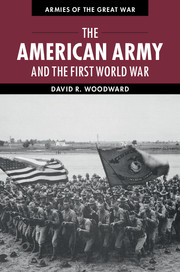Book contents
- Frontmatter
- Dedication
- Contents
- List of figures
- List of maps
- List of tables
- Preface
- List of abbreviations
- Introduction
- 1 Birth of a modern army
- 2 World war and American preparedness
- 3 Coercive power and Wilsonian diplomacy
- 4 “You’re in the army now”
- 5 US army doctrine and industrialized trench warfare
- 6 Over where?
- 7 American Expeditionary Force organization, overseas training, and deployment
- 8 Will the Americans arrive in time?
- 9 Failed expectations: “the military establishment of the United States has fallen down”
- 10 Atlantic ferry
- 11 Neck of the bottle
- 12 Uncertain times
- 13 Cantigny
- 14 Into the breach
- 15 American soldiers in north Russia and Siberia
- 16 The beginning of the end
- 17 Establishment of the American First Army and Saint-Mihiel
- 18 Meuse-Argonne, September 26–October 31
- 19 Breakout, November 1–11
- 20 Epilogue
- Notes
- Bibliography
- Index
13 - Cantigny
Published online by Cambridge University Press: 05 July 2014
- Frontmatter
- Dedication
- Contents
- List of figures
- List of maps
- List of tables
- Preface
- List of abbreviations
- Introduction
- 1 Birth of a modern army
- 2 World war and American preparedness
- 3 Coercive power and Wilsonian diplomacy
- 4 “You’re in the army now”
- 5 US army doctrine and industrialized trench warfare
- 6 Over where?
- 7 American Expeditionary Force organization, overseas training, and deployment
- 8 Will the Americans arrive in time?
- 9 Failed expectations: “the military establishment of the United States has fallen down”
- 10 Atlantic ferry
- 11 Neck of the bottle
- 12 Uncertain times
- 13 Cantigny
- 14 Into the breach
- 15 American soldiers in north Russia and Siberia
- 16 The beginning of the end
- 17 Establishment of the American First Army and Saint-Mihiel
- 18 Meuse-Argonne, September 26–October 31
- 19 Breakout, November 1–11
- 20 Epilogue
- Notes
- Bibliography
- Index
Summary
By the previous standards of trench warfare on the Western Front Ludendorff’s offensives in March and April had been great successes. His armies twice broke through the British front and rapidly advanced across open terrain. But the semi-mobility achieved by the rupture of the British front could not be maintained, and these break-ins could not be converted to a break-out. Slow-moving and often unreliable tanks (of which the Germans had few) could not maintain the momentum of the drive. Nor could mounted soldiers who were extremely vulnerable to machine guns. Cratered battlefields made the forward movement of big guns difficult, and infantry proved helpless once it got beyond the range of its own artillery. Logistics also played a central role as German troops marched well beyond their railheads. As infantry outdistanced its artillery and supplies these offensives lost their momentum and inevitably ground to a halt. The will of the British remained unbroken.
As his casualties mounted, Ludendorff’s position began to appear untenable. “He had become a typical chair-borne general who conducted operations from an office desk,” concluded Walter Goerlitz. “Clausewitz had designated strategy as the art of applying available means. Ludendorff could no longer distinguish between what was possible and what was not. Everything was possible if you barked out the order for it in a loud, gruff tone of voice.” His offensives created bulges in the enemy’s front but they also created vulnerable salients his own troops had to defend. Occupying makeshift defenses along an expanded front with precarious flanks, his armies were now much more vulnerable than previously when they occupied the strongest defensive positions on the Western Front.
- Type
- Chapter
- Information
- The American Army and the First World War , pp. 222 - 232Publisher: Cambridge University PressPrint publication year: 2014

